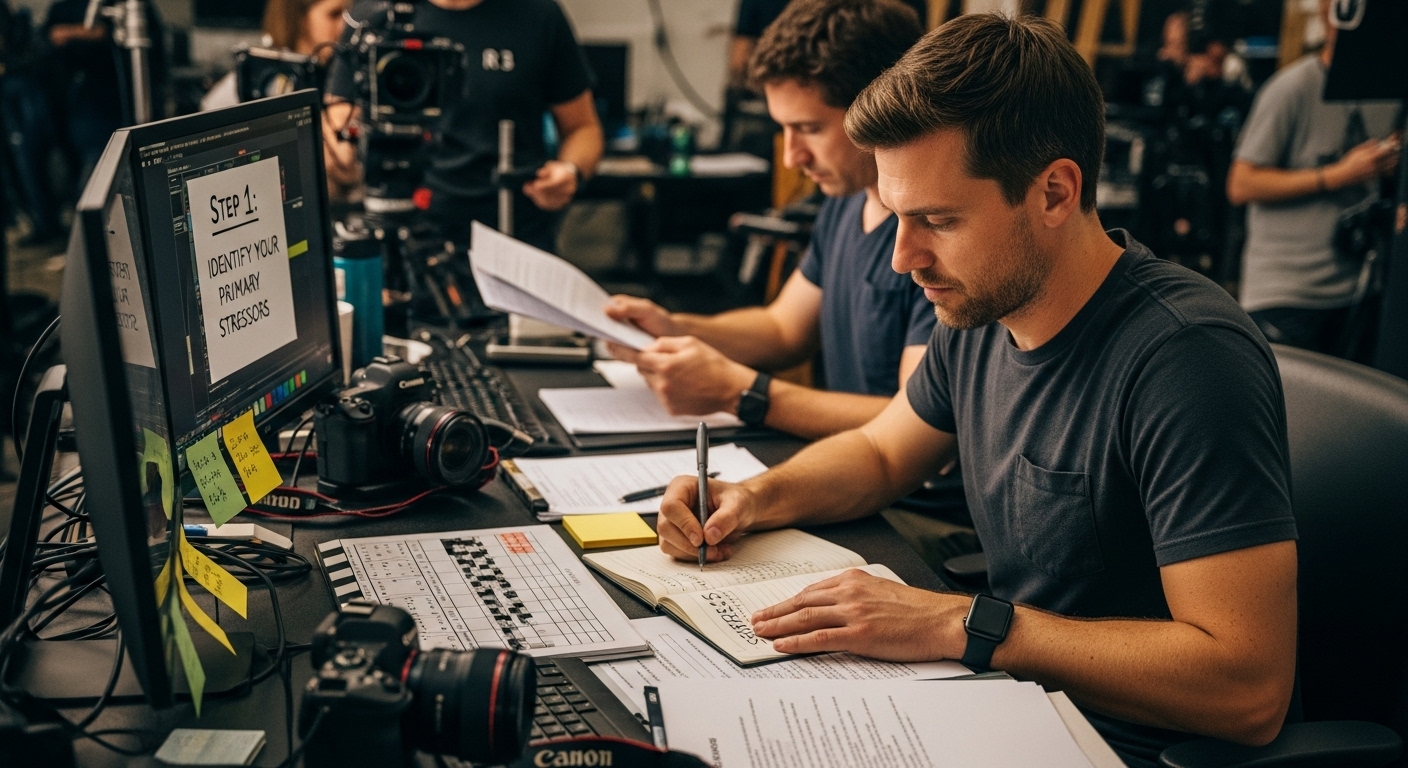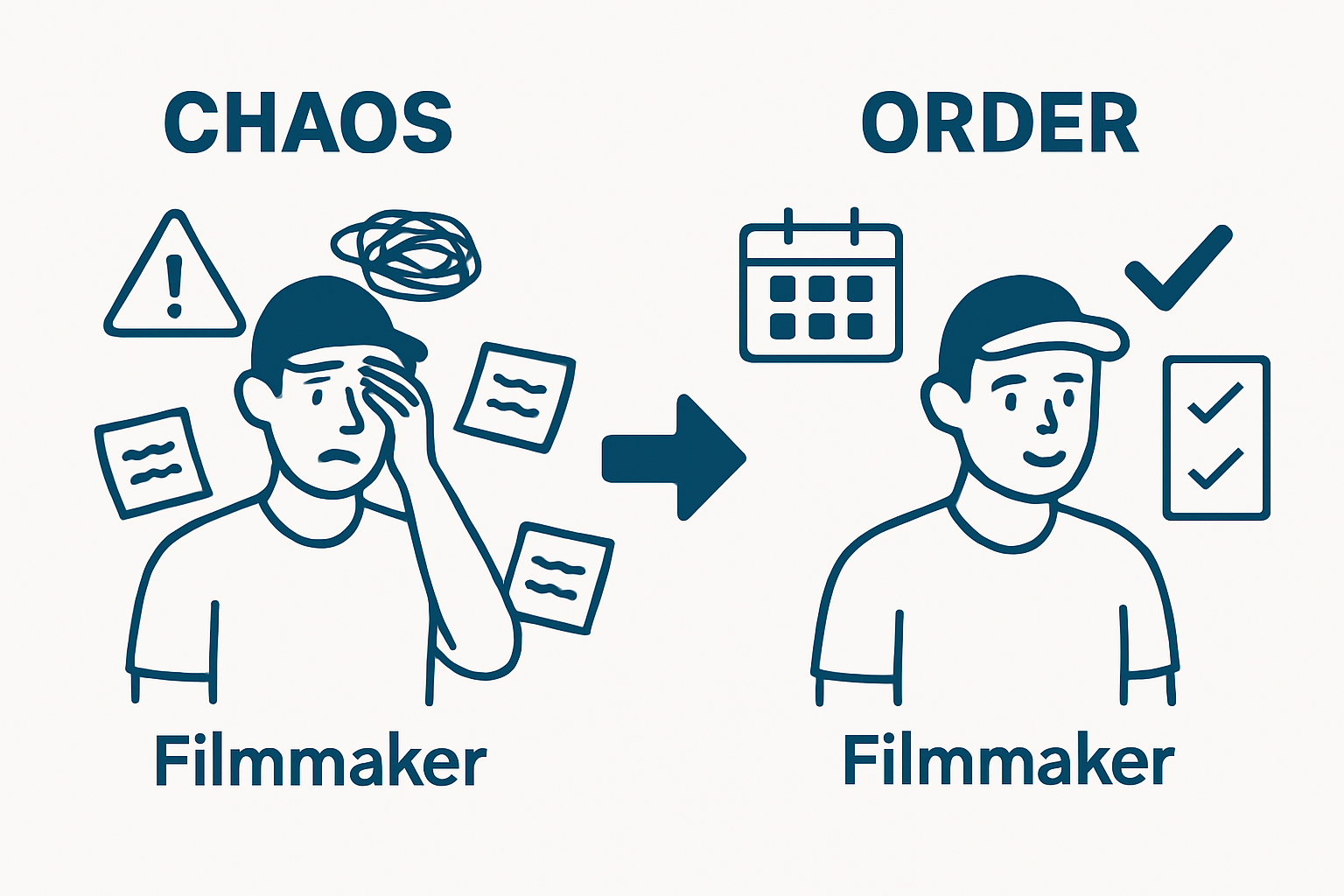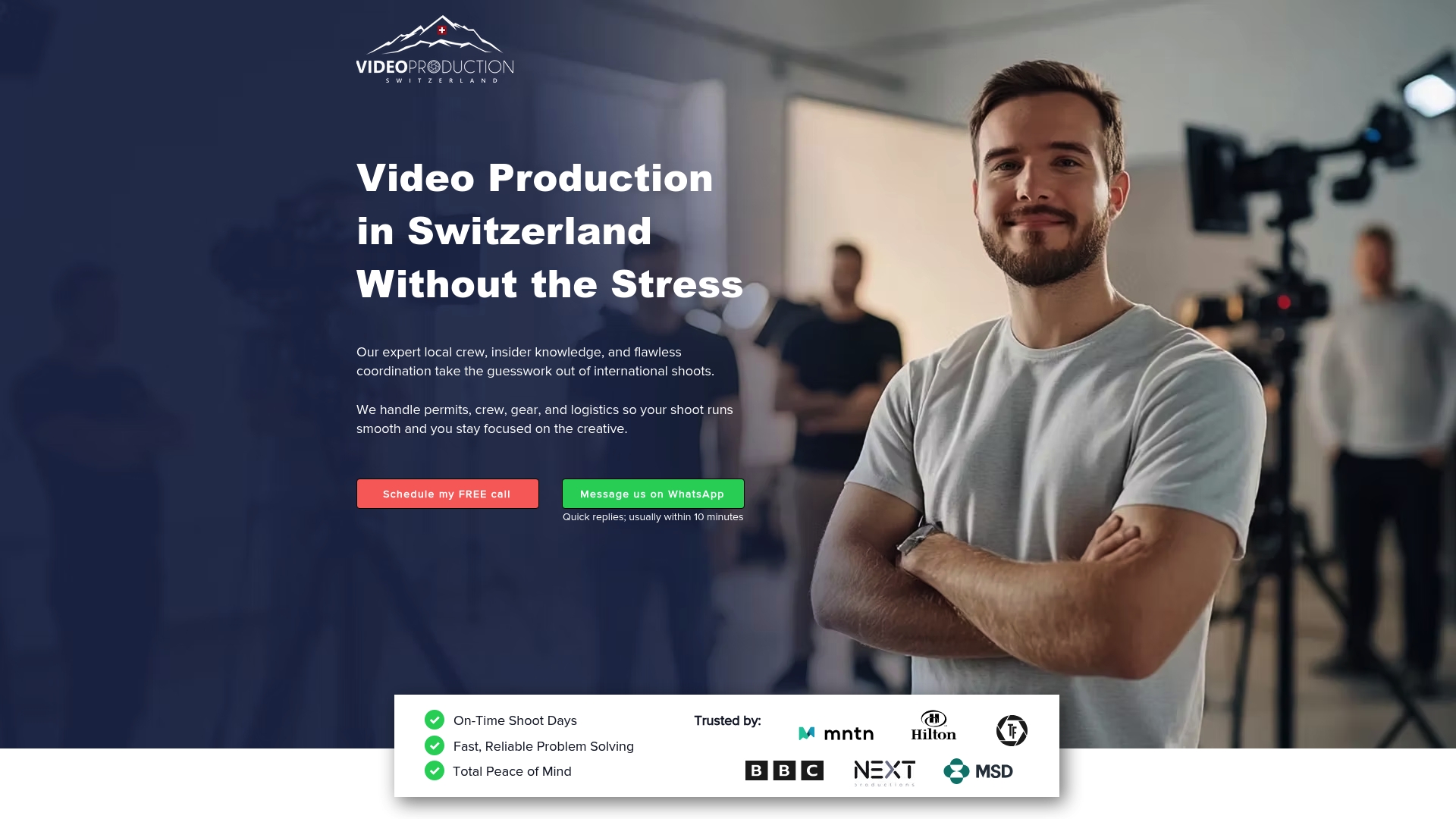Effective Stress Reducer Techniques for Filmmakers
- info1419758
- Sep 28
- 9 min read

Stress is a constant companion in the world of filmmaking, where every project brings new challenges and deadlines that pile up fast. Most people think successful filmmakers have mastered stress management, only to find out that nearly 76 percent of creative professionals report experiencing severe work-related anxiety each year. The real secret is not about working harder or longer, but about learning how to transform stress from a hidden saboteur into a powerful tool for creative control.
Table of Contents
Quick Summary
Key Point | Explanation |
1. Identify Your Stressors | Track specific moments that cause anxiety in your filmmaking workflow to recognize patterns in stress triggers. |
2. Create a Structured Work Schedule | Develop a flexible schedule that allows time for creative tasks, breaks, and buffers for unexpected issues. |
3. Incorporate Daily Mindfulness Practices | Engage in brief mindfulness exercises daily to enhance emotional resilience and maintain focus during stressful periods. |
4. Establish Supportive Communication Channels | Implement clear communication protocols to foster openness and collaboration among your team, reducing potential conflicts. |
5. Regularly Evaluate and Adjust Strategies | Conduct assessments of your stress management techniques to ensure effectiveness and adapt to changing professional needs. |
Step 1: Identify Your Primary Stressors
As a filmmaker, navigating stress requires first understanding its unique origins within your professional landscape. Stress reducer techniques begin with precise identification of what triggers your emotional and professional tension. The complexity of film production creates multiple potential stress points that can quickly overwhelm even experienced professionals.
The process of identifying stressors demands honest self reflection and systematic analysis. Start by creating a comprehensive stress journal where you document specific moments, interactions, and scenarios that generate significant anxiety during your filmmaking workflow. Track details like project stage, team dynamics, technical challenges, financial pressures, and personal emotional responses. Look for patterns that emerge over multiple entries.
According to American Psychological Association, recognizing sources of stress is critical for developing targeted coping mechanisms. For filmmakers, stressors might include budget constraints, tight production schedules, equipment failures, creative differences, talent management challenges, or unexpected logistical complications. Some professionals experience stress from high stakes project outcomes, client expectations, or personal reputation management.
Key Stress Identification Methods:
Maintain a daily stress tracking log
Analyze emotional and physiological responses during challenging project moments
Consult with professional peers about common industry stress triggers
Review past project retrospectives for recurring stress patterns
To effectively map your personal stress landscape, categorize identified stressors into controllable and uncontrollable domains. Controllable stressors represent areas where you can implement direct intervention strategies. Uncontrollable stressors require acceptance and development of emotional resilience techniques. This nuanced approach transforms stress identification from a passive observation into an active problem solving process.
Below is a summary table comparing common controllable and uncontrollable stressors filmmakers face, aiding in more targeted stress management strategies.
Stressor Type | Example Stressors | Can Be Directly Managed? | Suggested Focus |
Controllable | Budget limitations, workflow chaos, communication issues | Yes | Implement proactive strategies |
Scheduling conflicts, team conflict, equipment checklists | (planning, delegation, scheduling) | ||
Uncontrollable | Weather delays, location permit issues, sudden illness | No | Practice acceptance, build resilience |
Client last-minute changes, industry rule changes | (adaptability, emotional regulation) |

Successful stress identification involves brutal honesty and a commitment to professional self awareness. By meticulously documenting and analyzing your stress triggers, you create a foundational roadmap for developing personalized stress reducer techniques tailored specifically to your filmmaking experience.
Step 2: Create a Structured Work Schedule
Transitioning from stress identification to proactive management requires developing a robust and flexible work schedule that acts as a stress reducer for filmmakers. A structured approach transforms chaotic production environments into predictable, manageable workflows. Your schedule becomes more than a simple timeline it becomes a strategic tool for professional equilibrium.
Begin by implementing a digital project management system that allows comprehensive tracking of every project element. Tools like Trello or Asana enable granular breakdown of tasks, deadlines, and responsibilities. Block your time strategically allocating specific hours for creative work, administrative tasks, team collaboration, and personal recovery. Prioritize tasks based on complexity and energy requirements, scheduling most demanding creative work during your peak mental performance hours.
According to American Psychological Association, clearly defined roles and organized schedules significantly reduce workplace stress. For filmmakers, this means creating a schedule that accounts for unpredictable production dynamics while maintaining core structural integrity. Design your workflow with deliberate buffer zones that accommodate unexpected challenges without derailing entire project timelines.
Essential Schedule Management Strategies:
Allocate specific time blocks for focused creative work
Include mandatory breaks and recovery periods
Establish clear boundaries between professional and personal time
Build flexibility into your scheduling framework
Implement a color coded time tracking system where different project phases and task types receive distinct visual markers. This approach allows rapid visual assessment of project progress and potential stress points. Consider using digital calendars with integrated time blocking features that send automatic reminders and help maintain accountability.
Verify your schedule effectiveness by conducting weekly reviews. Assess how closely you adhered to the planned structure, identify bottlenecks, and make incremental adjustments. Remember that a stress reducer schedule is a living document that evolves with your professional growth and changing project demands.
This schedule management checklist helps ensure critical steps are implemented for stress reduction throughout the film production process.
Schedule Management Step | Completed | Notes |
Allocate specific creative work blocks | ||
Include mandatory breaks and downtime | ||
Set clear professional/personal boundaries | ||
Build schedule flexibility (buffer zones) | ||
Use digital tools for tracking | ||
Color-code tasks by phase or type | ||
Review and adjust weekly |

Step 3: Incorporate Mindfulness Practices Daily
Mindfulness emerges as a powerful stress reducer strategy for filmmakers navigating high pressure creative environments. This practice transcends traditional meditation, offering a dynamic approach to managing professional and emotional challenges inherent in film production. By integrating mindfulness into daily workflow, professionals can cultivate emotional resilience and maintain creative clarity.
Begin your mindfulness journey by establishing a morning ritual that centers your mental state before engaging with professional demands. Dedicate 10 to 15 minutes each morning to intentional breathing exercises, body scanning, and mental preparation. Use guided meditation applications like Headspace or Calm that provide structured, industry professional focused mindfulness sessions specifically designed for creative professionals.
According to National Center for Complementary and Integrative Health, consistent mindfulness practices can significantly reduce stress, improve emotional regulation, and enhance overall cognitive performance. For filmmakers, this translates into improved creative decision making, better team communication, and more balanced emotional responses during complex production scenarios.
Core Mindfulness Integration Techniques:
Practice 5 minute breathing exercises between production tasks
Implement short visualization techniques during high stress moments
Create mental reset protocols for challenging creative discussions
Develop personal grounding techniques specific to production environments
Integrate mindfulness directly into your professional workflow by establishing micro meditation moments throughout production days. These brief 2 to 3 minute interventions can be performed during equipment setup, between scene preparations, or during natural production pauses. Learn to recognize stress signals in your body and immediately respond with targeted breathing techniques that rapidly reset your nervous system.
Verify your mindfulness practice effectiveness by tracking emotional resilience, creative output, and interpersonal interactions. Maintain a reflection journal documenting your progress, noting improvements in stress management, creative problem solving, and overall professional satisfaction. Remember that mindfulness is a skill refined through consistent practice, not a one time solution. Your commitment to daily integration will gradually transform your professional experience, turning potential stress triggers into opportunities for growth and creative excellence.
Step 4: Establish Supportive Communication Channels
Effective communication serves as a critical stress reducer in the high pressure world of film production. Establishing robust, transparent communication channels transforms potential conflict zones into collaborative opportunities. This step focuses on creating an environment where team members can openly express concerns, share challenges, and work collectively towards project success.
Begin by implementing a comprehensive communication protocol that defines clear expectations for interaction modes and frequency. Utilize professional communication platforms like Slack or Microsoft Teams that offer structured yet flexible communication frameworks. Create dedicated channels for different project aspects technical discussions, creative brainstorming, logistical coordination, and emotional support. Ensure these platforms allow both synchronous and asynchronous communication to accommodate different team member preferences and global time zones.
According to research on workplace communication, open and supportive communication significantly reduces perceived stress and fosters a collaborative work environment. For filmmakers, this means developing communication strategies that prioritize clarity, empathy, and proactive problem solving.
Essential Communication Channel Strategies:
Establish weekly team check in meetings
Create confidential feedback mechanisms
Develop clear escalation protocols for challenges
Implement transparent project status reporting
Design emotional intelligence workshops that train team members in effective communication techniques. Focus on active listening skills, constructive feedback delivery, and conflict resolution strategies. These workshops should emphasize the difference between professional critique and personal criticism, helping team members develop resilience and mutual respect.
Verify the effectiveness of your communication channels through regular anonymous surveys and one on one feedback sessions. Track metrics like team satisfaction, project turnaround times, and interpersonal dynamics. Remember that supportive communication is an ongoing process requiring consistent effort, adaptability, and genuine commitment to mutual understanding. By transforming communication from a transactional necessity to a collaborative art form, filmmakers can create environments that minimize stress and maximize creative potential.
Step 5: Evaluate and Adjust Strategies Regularly
Continuous improvement represents the cornerstone of effective stress reducer techniques for filmmakers. This final step transforms your stress management approach from a static intervention into a dynamic, responsive system that evolves with your professional landscape. Regular evaluation ensures that your strategies remain relevant, effective, and aligned with your changing creative and professional needs.
Establish a quarterly performance and wellness assessment that goes beyond traditional project reviews. Create a comprehensive tracking system using digital tools like Notion or Airtable to document stress levels, creative output, emotional resilience, and professional satisfaction. Design a personal metrics dashboard that allows objective measurement of your stress management interventions. Include quantitative data such as project completion rates, missed deadlines, interpersonal conflict frequency, and subjective measures like energy levels and creative enthusiasm.
According to research on worksite stress management, regular assessment of intervention strategies allows professionals to refine techniques and ensure sustained improvements in overall well-being. For filmmakers, this means developing a nuanced, adaptive approach to stress management that recognizes the dynamic nature of creative work.
Key Evaluation and Adjustment Strategies:
Conduct monthly self reflection sessions
Track physical and emotional wellness indicators
Compare current strategies against professional goals
Remain open to experimenting with new stress reduction techniques
Implement a holistic feedback loop that incorporates perspectives from multiple sources. Engage trusted colleagues, mentors, and mental health professionals to provide external insights into your stress management approach. These conversations can reveal blind spots and offer innovative strategies you might have overlooked. Be prepared to discard techniques that no longer serve you and embrace new methodologies that align with your evolving professional identity.
Verify the effectiveness of your evaluation process by noting tangible improvements in project outcomes, personal well-being, and creative resilience. A successful stress reducer strategy is not about eliminating stress entirely but about developing the flexibility to navigate professional challenges with grace, creativity, and emotional intelligence. Your commitment to continuous assessment transforms stress management from a passive experience into an active, empowering journey of professional and personal growth.
Cut Production Stress with Local Expertise
Are recurring stress triggers like tight schedules, permits, or location headaches making your filmmaking journey more overwhelming than creative? What if you could focus entirely on your craft and let trusted professionals handle permits, logistics, and crew coordination? That is where Video Production Switzerland steps in. We understand the unique stressors creative teams face, especially when managing complex international shoots in an unfamiliar country. Our services directly address the very pressure points covered in our article, including unpredictable project challenges, logistics, and local compliance.

Experience the ultimate stress reducer for filmmakers by letting our local experts handle every logistical detail. With over 20 years of experience, we take care of permits, equipment sourcing, location scouting, and accommodations, so you can focus on creativity. Discover how our client-centric approach and in-depth market knowledge can turn potential stress into seamless execution. Start your next shoot in Switzerland stress-free with a free consultation. Visit our full service platform now and take the first step towards a truly smooth film production.
Frequently Asked Questions
What are some common stressors for filmmakers?
Filmmakers often face stress from budget constraints, tight schedules, equipment failures, creative differences, and talent management challenges. Emotional responses to high-stakes project outcomes and client expectations can also contribute to stress.
How can I effectively identify my stressors as a filmmaker?
To identify stressors, maintain a daily stress tracking log, analyze emotional and physiological responses during challenging moments, and consult with peers about common industry stress triggers. Look for recurring patterns in your experiences and categorize stressors into controllable and uncontrollable domains.
How can mindfulness practices help reduce stress in filmmaking?
Mindfulness practices can improve emotional regulation and cognitive performance. By integrating mindfulness into daily routines, filmmakers can cultivate emotional resilience, enhance creative decision-making, and maintain clarity during high-pressure situations.
Why is effective communication important for reducing stress in film production?
Effective communication minimizes misunderstandings and fosters a collaborative environment. By establishing open channels for feedback and regular check-ins, teams can address concerns quickly, reducing overall stress and enhancing project success.
Recommended
Effective Time Management in Production for Global Media Teams
Understanding Team Communication Best Practices for Filmmakers
Understanding Balancing Cost and Quality in Media Production
Stress Reduction Techniques for Aviation Professionals - VictorOne
Discover Our Top 3 CBD Strains for Effective Stress Relief – California Blendz

Comments